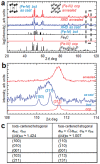Direct Formation of Hard-Magnetic Tetrataenite in Bulk Alloy Castings
- PMID: 36281692
- PMCID: PMC9811435
- DOI: 10.1002/advs.202204315
Direct Formation of Hard-Magnetic Tetrataenite in Bulk Alloy Castings
Retraction in
-
RETRACTION: Direct Formation of Hard-Magnetic Tetrataenite in Bulk Alloy Castings.Adv Sci (Weinh). 2025 Jan;12(4):e2416229. doi: 10.1002/advs.202416229. Epub 2024 Dec 18. Adv Sci (Weinh). 2025. PMID: 39691068 Free PMC article.
Abstract
Currently, predominant high-performance permanent magnets contain rare-earth elements. In the search for rare-earth-free alternates, body-centered tetragonal Fe-Ni is notable. The ordering to form this phase from the usual cubic close-packed Fe-Ni is understood to be possible only below a critical temperature, commonly accepted to be 593 K. The ordering is first demonstrated by using neutron irradiation to accelerate atomic diffusion. The tetragonal phase, designated as the mineral tetrataenite, is found in Fe-based meteorites, its formation attributed to ultra-slow cooling. Despite many attempts with diverse approaches, bulk synthesis of tetrataenite has not been reported. Here it is shown that with appropriate alloy compositions, bulk synthesis of tetrataenite is possible, even in conventional casting at cooling rates 11-15 orders of magnitude higher than in meteorites. The barrier to obtaining tetrataenite (slow ordering from cubic close-packed to body-centered tetragonal) is circumvented, opening a processing window for potential rare-earth-free permanent magnets. The formation of tetrataenite on industrially practicable timescales also throws into question the interpretation of its formation in meteorites and their associated cooling rates.
Keywords: meteorite; order-disorder; rare-earth-free permanent magnet; tetrataenite.
© 2022 The Authors. Advanced Science published by Wiley-VCH GmbH.
Conflict of interest statement
The authors declare no conflict of interest.
Figures






References
-
- Lewis L. H., Mubarok A., Poirier E., Bordeaux N., Manchanda P., Kashyap A., Skomski R., Goldstein J., Pinkerton F. E., Mishra R. K., Kubic Jr R. C., Barmak K., J. Phys. Condens. Matter 2014, 26, 064213. - PubMed
-
- Cui J., J. M. K., Zhou L., Liu F., Gabay A., Hadjipanayis G., Balasubramanian B., Sellmyer D., Acta Mater. 2018, 158, 118.
-
- Paulevé J., Dautreppe D., Laugier J., Néel L., J. Phys. Radium 1962, 23, 841.
-
- Petersen J. F., Aydin M., Knudsen J. M., Phys. Lett. 1977, 62A, 192.
-
- Clarke Jr R. S., Scott E. R. D., Amer. Mineral. 1980, 65, 624.
Publication types
Grants and funding
LinkOut - more resources
Full Text Sources
